Cell Culture Protein Surface Coatings Market Size
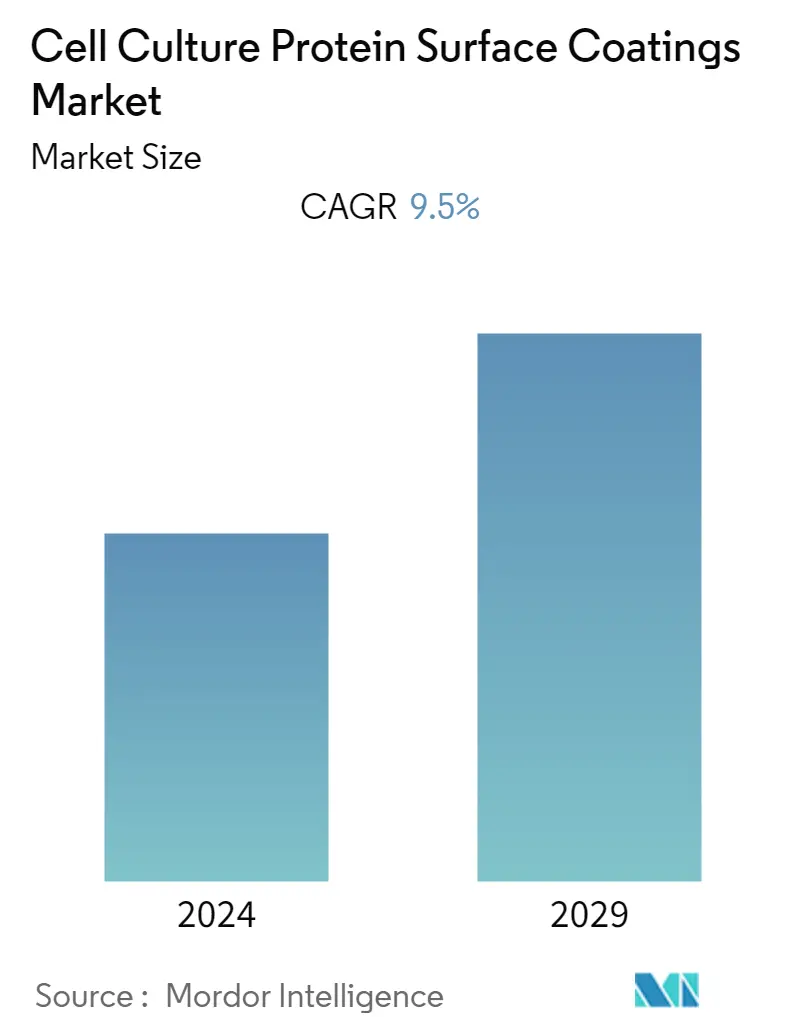
| Study Period | 2019 - 2029 |
| Base Year For Estimation | 2023 |
| Forecast Data Period | 2024 - 2029 |
| CAGR | 9.50 % |
| Fastest Growing Market | Asia-Pacific |
| Largest Market | North America |
Major Players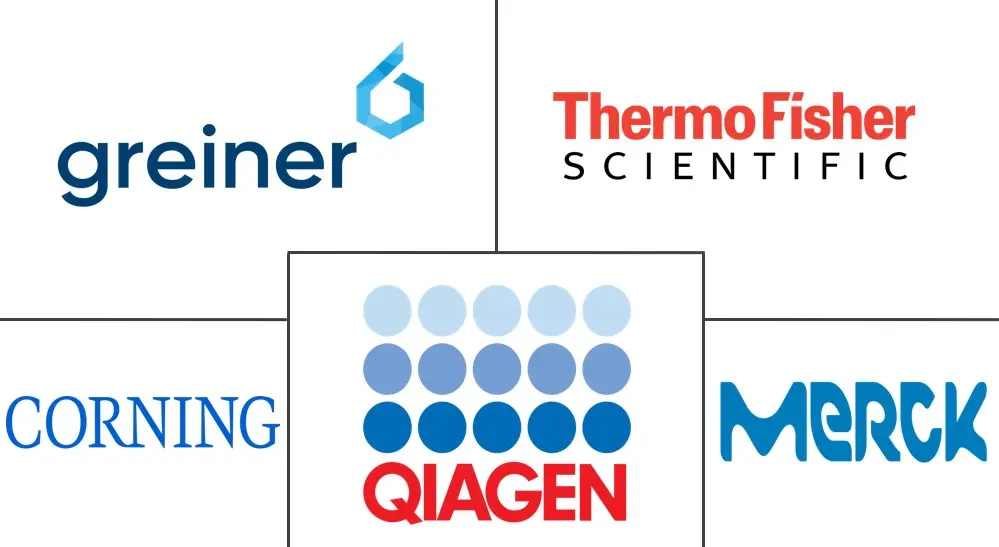
*Disclaimer: Major Players sorted in no particular order |
Cell Culture Protein Surface Coatings Market Analysis
The cell culture protein surface coatings market is expected to register a CAGR of 9.5% over the forecast period. When COVID-19 first appeared, a lot of biotech and pharmaceutical companies, governments from different nations, and research institutions began to concentrate on the creation of efficient vaccines and novel treatments to treat the problem. The creation of new vaccines for the treatment of COVID-19 was facilitated by cell culture.
- As per the report published by the Journal of Clinical Virology in July 2022, there was a significant positive correlation between the probability of isolating SARS-CoV-2 in culture, fewer days of symptoms, and a lower RT-PCR cycle threshold value. Hence the cell culture was used during COVID-19 for proper diagnosis and was expected to grow the cell culture protein surface coatings market. As viral studies are still ongoing, it is expected to have a significant impact in the coming future.
- The major factors, such as increasing stem cell research activities, increasing demand for protein therapeutics and targeted therapy, and growing preference for 3D cell cultures over 2D cell cultures, are driving the growth of the market over the forecast period.
- The optimization of the cell culture environment enables cells to grow, function, and survive in a realistic and representative manner. The surface coating of cell culture with protein involves coating the cell culture surface with extracellular matrix or protein components to improve the proliferation and adhesion of the cells in-vitro. Increasing stem cell research activities are expected to have a positive impact on the growth of the market.
- For instance, in June 2022, the Harvard Stem Cell Institute (HSCI) invited applications for seed grant funding for its 2022 cycle. The program's objective is to offer financial support for creative initiatives in the field of stem cell and regenerative biology to accelerate the development of new stem cell-based therapies or cures. As per the same above-mentioned source, the amounted award is USD 100,000 per project per year for up to two years. Thus the funding for the research activities increases the stem cell research activities that may drive the growth of the market over the forecast period.
- However, the high cost of cell culture protein surface coatings products and restrictions against the use of animal-source protein coating material may impede the growth of the market.
Cell Culture Protein Surface Coatings Market Trends
This section covers the major market trends shaping the Cell Culture Protein Surface Coatings Market according to our research experts:
Microwell Plates Under Pre-coatings Expected to Grow Over the Forecast Period
- Microwell plates are also known as microplates or microtiter plates, or multiwells. The microplate has become a standard tool in analytical research and clinical diagnostic testing laboratories. Depending on the cell type, passage, origin, and makeup of the cell culture media, cells in culture adhere to the culture plates in various ways, even when they are grown on plastic made specifically for cell culture.
- The new advancements and approvals, and launches among the microwell plates drive the market growth over the study period. For instance, in April 2022, the Porvair Sciences Sero Krystal PDL family of coated microplates sets a new standard for repeatable cell culture, even with difficult cell types.
- The advanced microplate readers in the market increase the usage of microplates in biotechnology that, drive the market. For instance, in April 2022, Molecular Devices LLC launched its SpectraMax mini multi-mode microplate reader, a compact and economical solution designed to save researchers benchtop space and budget. Similarly, in February 2022, BMG LABTECH launched the VANTAstar microplate reader, further expanding its range of high-quality, made-in-Germany instruments. VANTAstar is a compact multi-mode microplate reader and is equipped with three features that enable an effortless detection setup and improve data quality.
- Hence, the above advancements and launches are expected to have a significant impact on the market through the segment.
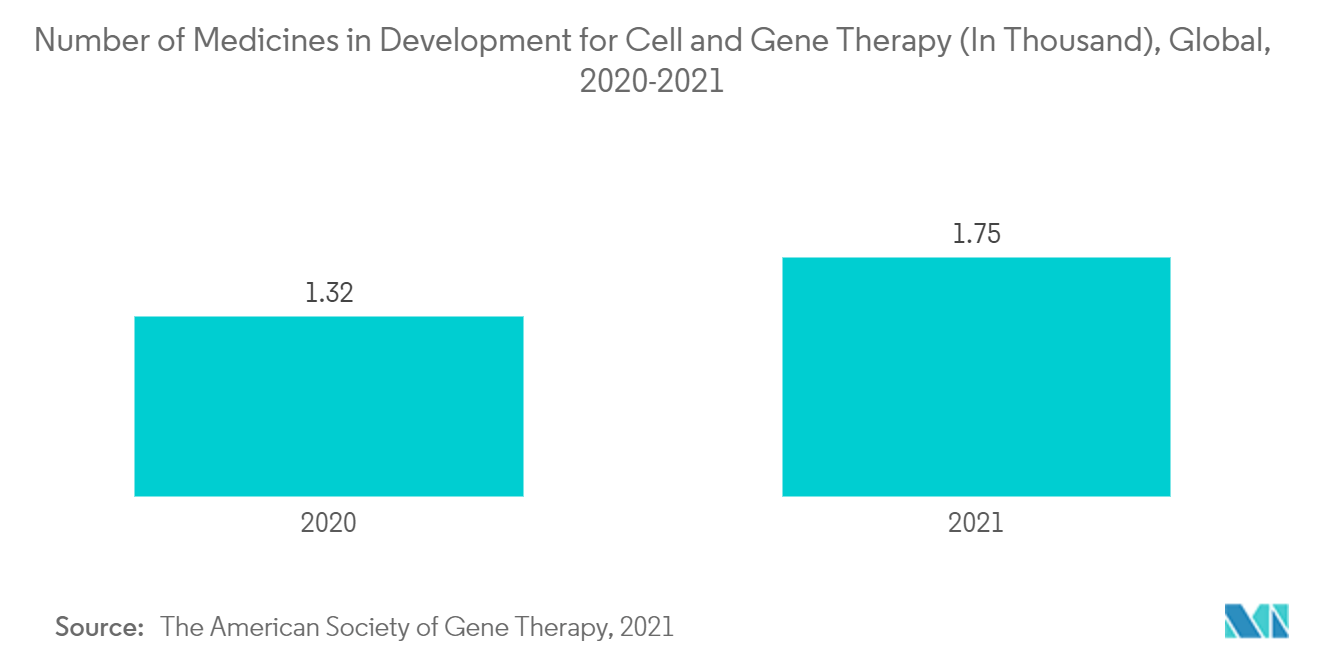
North America Estimated to Hold the Largest Share in the Market
- North America is well known for its cell culture laboratories and funding for research in the healthcare domain. And it is expected to dominate the market over the forecast period. Every year in the United States, the National Institutes of Health (NIH) heavily funds stem cell research. For research in cancer diseases and personalized medicine, the National Cancer Institute (NCI) allocates high funds to universities and companies collaborating with research centers.
- The American Cancer Society predicts that in 2022, there will be an estimated 1,918,030 new cases of cancer in the United States. The rise in cancer cases increases the demand for targeted therapies which involve cell cultures and hence are expected to have a significant impact on the market over the forecast period. Additionally, in February 2022, KromaTiD launched a comprehensive suite of cell and blood culture growth, isolation, processing, and quality control services. Such factors boost the importance of cell culture activities.
- Additionally, the expansion of the major players in the market also has a significant impact on the market. For instance, in July 2021, Abcam, a global innovator in life sciences reagents and tools, opened a major new site in Waltham, Massachusetts, United States. The new facility is a central component of Abcam's growth in the United States, reinforcing its commitment to support the research and biopharma sector.
- Thus, owing to the abovementioned factors, the studied market in the North American region is expected to show considerable growth over the forecast period.
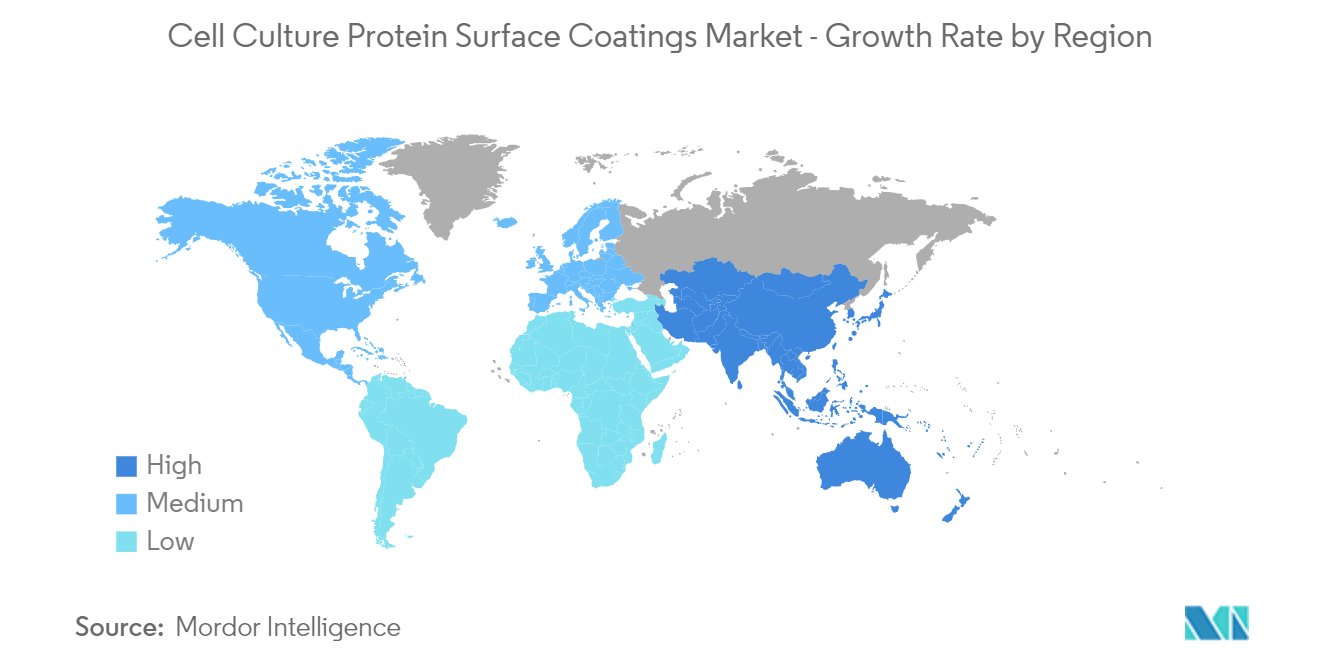
Cell Culture Protein Surface Coatings Industry Overview
The cell culture protein surface coating market is moderately fragmented and consists of several major players. The major market players are focusing on technological advancements in protein technology and cell culture techniques. Some of the major players in the market are Abcam PLC, Corning Incorporated, Greiner AG (Greiner Bio-One International GmbH), Merck KGaA, Promega Corporation, Sartorius AG, Qiagen NV, Viogene, and Thermo Fisher Scientific Inc.
Cell Culture Protein Surface Coatings Market Leaders
-
Corning Incorporated
-
Qiagen NV
-
Thermo Fisher Scientific Inc.
-
Greiner AG (Greiner Bio-One International GmbH)
-
Merck KGaA
*Disclaimer: Major Players sorted in no particular order
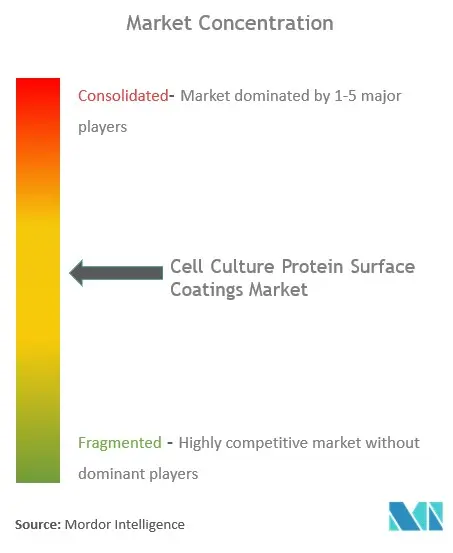
Cell Culture Protein Surface Coatings Market News
- April 2022: Molecular Devices LLC has been continuing its investment since April 2021 in Organoid Innovation Center, adding cell engineering capabilities to an automated 3D cell culture platform.
- December 2021: DenovoMATRIX launched its new product, isoMATRIX, a high-yield MSC isolation technology for cell and gene therapy. It has the efficiency to get nearly 35% more stem cells with better quality and faster growth.
Cell Culture Protein Surface Coatings Market Report - Table of Contents
1. INTRODUCTION
- 1.1 Study Assumptions and Market Definition
- 1.2 Scope of the Study
2. RESEARCH METHODOLOGY
3. EXECUTIVE SUMMARY
4. MARKET DYNAMICS
- 4.1 Market Overview
-
4.2 Market Drivers
- 4.2.1 Increasing Stem Cell Research Activities
- 4.2.2 Increasing Demand of Protein Therapeutics and Targeted Therapy
- 4.2.3 Growing Preference for 3D Cell Cultures over 2D Cell Cultures
-
4.3 Market Restraints
- 4.3.1 High Cost of Cell Culture Protein Surface Coatings Products
- 4.3.2 Restriction Against Use of Animal Source Protein Coating Material
-
4.4 Porter's Five Forces Analysis
- 4.4.1 Threat of New Entrants
- 4.4.2 Bargaining Power of Buyers/Consumers
- 4.4.3 Bargaining Power of Suppliers
- 4.4.4 Threat of Substitute Products
- 4.4.5 Intensity of Competitive Rivalry
5. MARKET SEGMENTATION (Market Size by Value - USD million)
-
5.1 By Protein Source
- 5.1.1 Animal-derived Protein
- 5.1.2 Human-derived Protein
- 5.1.3 Synthetic Protein
- 5.1.4 Plant-derived Protein
-
5.2 By Type of Coating
- 5.2.1 Self-coating
- 5.2.2 Pre-coating
- 5.2.2.1 Microwell Plates
- 5.2.2.2 Petri Dish
- 5.2.2.3 Flask
- 5.2.2.4 Slides
- 5.2.2.5 Other Types of Pre-coatings
-
5.3 Geography
- 5.3.1 North America
- 5.3.1.1 United States
- 5.3.1.2 Canada
- 5.3.1.3 Mexico
- 5.3.2 Europe
- 5.3.2.1 France
- 5.3.2.2 Germany
- 5.3.2.3 United Kingsom
- 5.3.2.4 Italy
- 5.3.2.5 Spain
- 5.3.2.6 Rest of Europe
- 5.3.3 Asia-Pacific
- 5.3.3.1 China
- 5.3.3.2 Japan
- 5.3.3.3 India
- 5.3.3.4 Australia
- 5.3.3.5 South Korea
- 5.3.3.6 Rest of Asia-Pacific
- 5.3.4 Middle East and Africa
- 5.3.4.1 GCC
- 5.3.4.2 South Africa
- 5.3.4.3 Rest of Middle East and Africa
- 5.3.5 South America
- 5.3.5.1 Brazil
- 5.3.5.2 Argentina
- 5.3.5.3 Rest of South America
6. COMPETITIVE LANDSCAPE
-
6.1 Company Profiles
- 6.1.1 Abcam PLC
- 6.1.2 Corning Incorporated
- 6.1.3 Greiner AG (Greiner Bio-One International GmbH)
- 6.1.4 Merck KGaA
- 6.1.5 Promega Corporation
- 6.1.6 Qiagen NV
- 6.1.7 Sartorius AG
- 6.1.8 Thermo Fisher Scientific Inc.
- 6.1.9 Viogene
- *List Not Exhaustive
7. MARKET OPPORTUNITIES AND FUTURE TRENDS
** Subject To AvailablityCell Culture Protein Surface Coatings Industry Segmentation
As per the scope of the report, coating as an additional surface treatment stands for all additional modifications made to increase cell adhesion. The cell culture protein surface coatings market is expected to register a CAGR of 9.5% over the forecast period. The cell culture protein surface coatings market is segmented by protein source (animal-derived protein, human-derived protein, synthetic protein, and plant-derived protein), type of coating (self-coating and pre-coatings), and geography (North America, Europe, Asia-Pacific, Middle East, and Africa, and South America). The report also covers the estimated market sizes and trends for 17 countries across major regions globally. The report offers the value (in USD million) for the above segments.
| By Protein Source | Animal-derived Protein | |
| Human-derived Protein | ||
| Synthetic Protein | ||
| Plant-derived Protein | ||
| By Type of Coating | Self-coating | |
| Pre-coating | Microwell Plates | |
| Petri Dish | ||
| Flask | ||
| Slides | ||
| Other Types of Pre-coatings | ||
| Geography | North America | United States |
| Canada | ||
| Mexico | ||
| Geography | Europe | France |
| Germany | ||
| United Kingsom | ||
| Italy | ||
| Spain | ||
| Rest of Europe | ||
| Geography | Asia-Pacific | China |
| Japan | ||
| India | ||
| Australia | ||
| South Korea | ||
| Rest of Asia-Pacific | ||
| Geography | Middle East and Africa | GCC |
| South Africa | ||
| Rest of Middle East and Africa | ||
| Geography | South America | Brazil |
| Argentina | ||
| Rest of South America |
Cell Culture Protein Surface Coatings Market Research FAQs
What is the current Cell Culture Protein Surface Coatings Market size?
The Cell Culture Protein Surface Coatings Market is projected to register a CAGR of 9.5% during the forecast period (2024-2029)
Who are the key players in Cell Culture Protein Surface Coatings Market?
Corning Incorporated, Qiagen NV, Thermo Fisher Scientific Inc., Greiner AG (Greiner Bio-One International GmbH) and Merck KGaA are the major companies operating in the Cell Culture Protein Surface Coatings Market.
Which is the fastest growing region in Cell Culture Protein Surface Coatings Market?
Asia-Pacific is estimated to grow at the highest CAGR over the forecast period (2024-2029).
Which region has the biggest share in Cell Culture Protein Surface Coatings Market?
In 2024, the North America accounts for the largest market share in Cell Culture Protein Surface Coatings Market.
What years does this Cell Culture Protein Surface Coatings Market cover?
The report covers the Cell Culture Protein Surface Coatings Market historical market size for years: 2019, 2020, 2021, 2022 and 2023. The report also forecasts the Cell Culture Protein Surface Coatings Market size for years: 2024, 2025, 2026, 2027, 2028 and 2029.
Cell Culture Protein Surface Coatings Industry Report
Statistics for the 2024 Cell Culture Protein Surface Coatings market share, size and revenue growth rate, created by Mordor Intelligence™ Industry Reports. Cell Culture Protein Surface Coatings analysis includes a market forecast outlook to 2029 and historical overview. Get a sample of this industry analysis as a free report PDF download.



